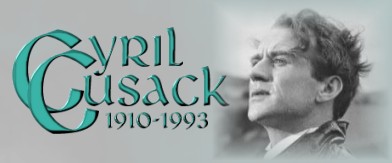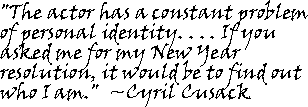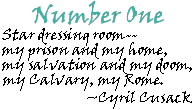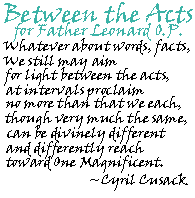![]()



|
Actor
of both stage and screen, theatre producer and manager, director,
playwright, poet, author, one of the most beloved and influential
people in Irish theatre: Cyril Cusack spent three-quarters of
a century delighting and engaging audiences.
|
The son of Cockney chorus-girl-turned-actress Alice Cole and Irish mounted police sergeant James Cusack, Cyril James Cusack was born in Durban, Natal, South Africa, on November 26, 1910. His parents divorced, and, at the age of 6, he moved with his mother to Ireland, where she raised him together with her companion, actor Brefni O'Rorke. They formed a touring theatrical company, the O'Brien and Ireland Players, with whom they travelled around the country on what Cusack later referred to as "a glorious adventure." ("I have been on my own all my life," he recalled, "except during those touring days.")
Young Cyril made his acting debut at the age of 6, appearing both onstage as Little Willie in the tearjerker East Lynne and in the silent film Knocknagow as a starving child during the Irish famine in the same year. (He later remarked on the irony that he "was rather a fat little boy ... perhaps I acted so well" that no one noticed.) He continued to perform alongside his mother and step-father, frequently changing schools, until the age of 13, when he was sent to a Dominican school in Newbridge, Kildare, to finish his education. He explored various professions before attending University College in Dublin from 1928 to 1932, where he studied modern history, Roman law, and politics with the intention of becoming a barrister. But he soon "found [himself] in the orbit of the Abbey Theatre" and was drawn into full-time acting before completing his studies.
At the age of 21, Cyril Cusack joined Dublin's renowned Abbey Theatre. (The Abbey was cofounded in 1904 by William Butler Yeats, Lady Augusta Gregory, and Edward Martyn, evolving from the Irish Literary Theatre they had established in 1898, although Cusack saluted actor brothers Willie and Frank Fay as its true founders. The siblings were the first to portray the characters of Shawn Keogh and Christy Mahon, respectively, in the original production of John Millington Synge's controversial portrait of Irish country folk, The Playboy of the Western World, in 1907.)
Cyril Cusack appeared in approximately 65 plays over the next 13 years, often playing leads and Shavian roles, in addition to directing the Gaelic Players from 1935-36.
In 1936, he made his London debut, appearing as Richard in O'Neill's Ah, Wilderness! The special connection he felt with the audience during that production left a lasting impression on him.
He received accolades when he took on what was to become one of his favorite roles, first at the Abbey in 1938 and the following year in London, one which he called "one of the most difficult parts for an actor" and was to reprise many times: Christy Mahon in The Playboy of the Western World. That same year, he brought another favorite role to the London stage: the Covey in The Plough and The Stars. He soon joined the prestigious Old Vic theatre company.
In 1943, though, his London success was abruptly interrupted. He was appearing at the Haymarket theatre as Dubedat opposite Vivien Leigh in Shaw's The Doctor's Dilemma. Two weeks into the production, he reported to the theatre ill and inebriated after being served some bad liquor during a lunchtime celebration of his saint's day. Nevertheless, he trooped on stage. Disoriented, he forgot his lines and instead began delivering dialog from The Playboy of the Western World. The curtain was brought down mid-performance. Rumors about the incident persist to this day. One of the more sordid versions of the story asserts that he even assaulted his flabbergasted costar. Although there was no understudy to replace him, the story goes on, it was a furious Laurence Olivier who had him immediately fired from the Old Vic. (More credible versions state that he was given the standard two weeks' notice while the understudy learned his lines.) Whatever the true details, Cusack did not appear on the London stage again for 20 years as a result of what he referred to as the "mishap."
He returned to Dublin and the Abbey Theatre. In 1944, he managed the Gaiety Theatre and formed Cyril Cusack Productions, continuing to act and direct plays (taking on the roles of Romeo--another favorite--and Hamlet among others) and promoting the work of Irish playwrights along with the classics. (He later expressed regret at his "chauvinistic" attitude. "Theatre has no national identity," he said, "it is something for the world, whether it is Irish, English, or French. ... I am a nationalist ... [but my] native soil is the theatre.")
In 1955, he produced and starred in the first performance of Sean O'Casey's The Bishop's Bonfire, directed by Tyrone Guthrie, but the critics gave it poor reviews. (In 1958, when further controversy erupted surrounding the production of another of O'Casey's plays, The Drums of Father Ned, the playwright, remembering his earlier play's reception, banned further staging of his work in Ireland until his death in 1964. "It is plain to me now that the Irish Producers, quite as strongly as the Critics, have neither sympathy nor understanding of my mode of playwriting," he wrote in his retraction of the play.) Notwithstanding prevailing critical opinion, however, The Bishop's Bonfire was a resounding hit with audiences. Reviewer Bourke MacWilliam called it "one of the most entertaining pieces of theatre to be produced in Ireland for a very long time," adding, "Had it been the work of a lesser writer that fact would have been recognised from the first: and the critical cymbals would have clashed a less discordant note." He also praised Cusack's "consummate artistry" in the role of the Codger. (O'Casey himself held the actor in high regard.) The play was so popular, Cusack turned down at least one offer to bring the production to London because the venue was too small.
By the early 1940s, he had already made several film appearances, notably 1935's silent Guests of the Nation (based on Frank O'Connor's short story about post-independence Ireland which later inspired the Oscar-winning hit The Crying Game), as well as Inspector Hornley Goes to It and Once a Crook, both in 1941. But his film career took off in 1947 when he appeared in his first major role as Pat, the bungling getaway-car driver, in Odd Man Out, Carol Reed's critically acclaimed film about the odyssey of a mortally wounded IRA leader (James Mason).
Primarily as a character actor, Cusack made over 100 films during the next 46 years of his life, branching into television in the 1960s and appearing as a regular in several British and Irish series. Although he generally enjoyed working with film directors (especially Carol Reed and François Truffaut) more than with theatre directors, among whom he had a reputation for being "difficult" although brilliant, the stage remained his central focus. In fact, many of his screen roles were undertaken to help finance his theatre endeavors (for which, at one point during the height of his success, he was reportedly earning only £30 a week). "The relationship with a live audience seems to me to count for more," he explained. "They say 6 million people see you when you act in a film; it may only be 600 in a play. But the effect on the 600 may be truer and more lasting." (In fact, Cusack's performance often depended on audience response, according to director Joe Dowling. Unresponsive crowds, typical of opening nights, made him nervous and tense.) Further, Cusack stated, "I love the theatre and theatre people." Quoting Ronald Knox, he called acting, "the most brotherly and sisterly profession in the world" and admitted that "in my younger years ... my dedication may have expressed itself egotistically. ... One's performance is often heightened by the brilliance and generosity of other actors." Even in his spare time, he enjoyed collecting theatre posters and other objets d'art related to the theatre, as well as reading theatrical biographies.
 Yet
his feelings about the acting profession and the idea of his own children's
following in his footsteps were mixed. "To maintain one's individuality,
integrity, and true personality in the theatre is a big task," he
said. "The actor has a constant problem of personal identity--I mean
the actor who's an artist, not a handyman. If you asked me for my New
Year resolution, it would be to find out who I am."
Yet
his feelings about the acting profession and the idea of his own children's
following in his footsteps were mixed. "To maintain one's individuality,
integrity, and true personality in the theatre is a big task," he
said. "The actor has a constant problem of personal identity--I mean
the actor who's an artist, not a handyman. If you asked me for my New
Year resolution, it would be to find out who I am."
In addition to stage, film, and TV work, Cusack also found time to lend his distinctive voice to numerous audio recordings, including audio performances of several Shakespeare plays and the poetry and plays of William Butler Yeats. His talent as a storyteller can be heard on two collections of Irish fairy tales, as well as in lively renditions of excerpts from James Joyce's Portrait of the Artist as a Young Man and Finnegans Wake, while sensuous readings of Joyce's love poetry further demonstrate his versatility. With Cyril Cusack Productions he preserved his classic interpretation of The Playboy of the Western World in audio format, as well as O'Casey's Juno and the Paycock, with O'Casey himself reading the opening and closing of the play. However, Cusack took the role of Joxer Daly rather than the lead: "I enjoyed playing in O'Casey. I followed Barry Fitzgerald as the Paycock when he went to America. I don't think I was a very good Paycock; in fact, I was a very bad Paycock, an echo of Fitzgerald."
In 1963, he returned to London and joined the Royal Shakespeare Company, with whom his first role was Mobius in Friedrich Dürrenmat's The Physicists. He was welcomed with open arms by critics and audiences alike. And in 1964, he rejoined the Old Vic, appearing as Can in Max Frisch's Andorra.
In 1966, Cusack accepted the Minister of Finance's invitation to serve on the board of the Irish National Theatre.
Feeling that melodrama was underrated, he achieved a longstanding dream in 1968 of reviving the work of Dion Boucicault, "with its spicing of comedy" and "its buoyant stress on the principles of justice and chivalry"--first at the Abbey Theatre and then at the World Theatre Season at the Aldwych Theatre in London. He received kudos from critics in the title role of Conn the Shaughraun.
Surprisingly, Cyril Cusack played few lead roles on film. Hal Erickson of the All Movie Guide blames this on his "diminutive stature." However, not only had he already played many leading roles on the stage (where an actor's height would be more difficult to disguise), but his slight build seemed not to concern filmmakers Powell and Pressburger, for example, when they cast him in a romantic part opposite the 5'7" Jennifer Jones in 1950's Gone to Earth. (The film was later re-edited and partially reshot by David O. Selznick for its 1952 American release as The Wild Heart.) In it, he gives a touching performance as the gentle country parson who courts and marries a free-spirited animal lover but must compete with a lascivious squire to keep her. He was also of a similar height to the lead, Edward Fox, in 1973's The Day of the Jackal, as well as his True Confessions costar Robert DeNiro. Nor has physical stature kept actors like Dustin Hoffman, Mickey Rooney, Tom Cruise, Michael J. Fox, or Al Pacino from leading roles. In fact, in 1963, Cusack reportedly turned down the title role on what would prove to be the longest-running sci-fi television series, Dr. Who.
More likely it was a combination of his determination to avoid being typecast as "the Hollywood Irishman" combined with his focus on the stage that led to his specialization in smaller (and therefore less time-consuming) but memorable supporting character roles in popular and highly acclaimed films, like The Spy Who Came in From the Cold (1965), Fahrenheit 451 (1966), The Abdication (1974), Jesus of Nazareth (1977),The Tenth Man (1988), My Left Foot (1989), and Far and Away (1992). His prestige was so great that he often was third or fourth billed when his appearance amounted to little more than a cameo. (Notable among these is his appearance in the 1971 cult comedy hit Harold and Maude, in which he had fourth billing but, in his 25 seconds of screen time, only one brief line.)
His impish looks, twinkling eyes, and lilting voice led to a preponderance of roles as clergymen. His gentle demeanor was exploited to perfect effect by director Michael Radford for the role of the antique dealer/landlord, Mr. Charrington, in 1984's chilling Nineteen Eighty-Four.
Yet given more screen time, he was quite capable of upstaging many of his larger-than-life contemporaries. In 1951, he played Private Dennis Malloy, one of the trio of troublemaking buddies in the lighthearted Soldiers Three. In it, even irrepressible ham Robert Newton is reduced to sidekick status by Cusack's winsome performance. (With his trademark "Arr!" and rolling eye, Newton had defined the quintessential movie pirate just a year before in Disney's classic Treasure Island.)
In 1967's Franco Zeffirelli-directed Burton/Taylor vehicle Taming of the Shrew, Cusack plays Grumio, the comic servant of the bombastic Petrucchio (Richard Burton). Though his lines are few, his clowning is a highlight of the movie, and a close-up of his mischievous twinkle closes the film.
Indeed, Cyril Cusack had a special talent for comedy and was known for his impeccable timing. As the eccentric Dr. Grogan in 1962's Waltz of the Toreadors, he gets a good share of the laughs even when sharing the screen with legendary comic pioneer Peter Sellers.
In his 1986 autobiography, Sir Alec Guinness counted Cusack beside Pierre Fresnay as one of his two favorite actors, whom he admired "this side of idolatry," citing Cusack's ability to create his "own centre-stage wherever [he was], even with [his back] to the audience." (Sharing a mutual admiration and a kindred approach to acting, Guinness and Cusack had worked briefly together on the aborted stage production of The Cherry Orchard at the outbreak of World War II. In 1965, both had lent their vocal talents to the Caedmon audio production of King Lear. They would finally appear together onscreen as brothers in the 1988 Dickens miniseries Little Dorrit--with Guinness in a leading role and Cusack in another small supporting one.)
The actor's delightful charm may have limited him in only one area: During the filming of Fahrenheit 451, in which he plays the book-burning fire chief, the ostensible villain of the picture, director Truffaut commented that, "He can play his scenes in so many styles; he can be baroque, malicious, lyrical, but he can never be terrifying."
 In
addition to portraying clergymen in his professional life (even being
mistaken for them on the street), Cusack described himself as "basically
a religious man," finding the search for truth (and avoidance of
pretense) to be the purpose of both religion and theatre work. A Catholic,
he believed that religion, with its paradoxes, "promotes the divine
discontent within oneself, so that one tries to make oneself a better
person and draw oneself closer to God." Among his favorite reading
material was the Old Testament, from which he read a passage every day.
In
addition to portraying clergymen in his professional life (even being
mistaken for them on the street), Cusack described himself as "basically
a religious man," finding the search for truth (and avoidance of
pretense) to be the purpose of both religion and theatre work. A Catholic,
he believed that religion, with its paradoxes, "promotes the divine
discontent within oneself, so that one tries to make oneself a better
person and draw oneself closer to God." Among his favorite reading
material was the Old Testament, from which he read a passage every day.
Cyril Cusack mostly worked in Ireland, the U.K., and the U.S., but in the late 1960s and early 1970s, he made a series of Italian movies, playing his first film lead in 1969's Galileo. He was also a "speaker" in the French film Le fond de l'air est rouge (The Base of the Air is Red) in 1977. He later suggested that Irish filmmakers follow the approach of the French and Italians by being "aware of the simple stories that emerge as lovely films or television pieces." In 1979, he returned to Ireland to lead a cast of not-very-likable characters in the Irish-language film Poitín, playing a distiller of Irish moonshine.
A fluent speaker of Irish Gaelic and strong supporter of its revival, Cusack had written and staged the play Tar Éis an Aifrinn (After the Mass) in 1942, and composed poetry in both Irish and English whenever he could find the time. He published his first volume, Timepieces, in 1970, and two more followed: Poems in 1976 and "Between the Acts" and Other Poems in 1990. In 1961, he staged another of his own plays, The Temptation of Mr. O, which he based on Franz Kafka's The Trial but set in Dublin. "I have tried to explore the little talent I have for writing," he said in 1972. "I have thought if I could possibly afford it--but I have a family of five--of giving up acting and trying to develop this other talent to its fullest." His poem "To Padraig, Newborn" was named one of the best poems of 1966 by the Borestone Awards.
In his 1980 book, Cyril Cusack's The Humour Is on Me, he collected anecdotes by 82 famous Irish (or honorary Irish) people (among them Maeve Binchy, Spike Milligan, Frederick Forsyth, Derek Bell of the Chieftains, future Irish president Mary Robinson, and his own daughter Sinéad), penning a reminiscence of his own and an introductory "Forward!" He also authored a number of published articles, including one on film appreciation for a 1953 issue of Focus, "A Player's Reflection on Playboy" for Modern Drama in 1961, and a chapter paying tribute to Alec Guiness for the 1989 anthology Dear Alec: Guinness at Seventy-Five edited by Ronald Harwood.
In addition to awards for his poetry, in 1961, he won the International Critics' Award at the Paris Festival for his productions of Arms and the Man and Krapp's Last Tape. He also won awards in Britain and the U.S. for his radio and television work. In 1977, 1980, and 1982, he received honorary doctorates from the National University of Ireland, University of Dublin, and University of Ulster respectively.
In spite of the extraordinary number of projects he took on throughout his life ("Nobody made more plans and schemes than Cyril Cusack," stated fellow actor Stephen Rea in Carol Zucker's In the Company of Actors), Cusack managed to make time to enjoy his hobbies of riding, collecting rare books, cycling, walking, and swimming well into his old age.
His first wife, stage actress Maureen Kiely, who had roles in his films Odd Man Out and The Rising of the Moon, died in 1977. They had five children, Sorcha, Sinéad, Niamh, Paul, and Pádraig. In 1979, he married Mary Rose Cunningham, with whom he had a daughter, Catherine. All four daughters have carried on the family acting tradition. Sinéad Cusack has appeared in many feature films, including 1996's Stealing Beauty. At the age of 21, she had appeared with her father in the star-studded 1969 TV movie David Copperfield and starred the following year opposite Peter Sellers in Hoffman. In 1978, she married actor Jeremy Irons, and their son Sam Irons appeared in the title role in the 1989 TV movie Danny, the Champion of the World alongside his father and grandfather. Niamh appeared in 1992's The Playboys with Aidan Quinn and Albert Finney. Sorcha is married to actor Nigel Cook and is active on the stage. Catherine joined the cast of the popular BBC television series Ballykissangel in 1999. Son Paul is a producer at Radio Telefís Éireann, and Pádraig works with computers. (There is no immediate relation to the popular American acting family whose members include siblings John and Joan Cusack.)
In 1990, Cusack appeared to critical acclaim with his daughters Sinéad, Sorcha, and Niamh onstage in Anton Chekhov's Three Sisters at London's Royal Court Theater and Dublin's Gate Theater. He found time to make only one film that year, The Fool, written and directed by Christine Edzard, who had also directed and written the screenplay for Little Dorrit.
The following year, he hosted a documentary on the history of the Jesuit priesthood entitled The Company: Inigo and His Jesuits in addition to opening the John Millington Synge Summer School.
In 1992, he was again busy in front of the camera, appearing on the American TV series The Young Indiana Jones Chronicles as French author and statesman Georges Clemenceau. He also hosted another documentary, this one about Celtic monasteries, and made three more films. The first was the Hollywood blockbuster Far and Away, directed by Ron Howard and starring Tom Cruise and Nicole Kidman as an Irish couple who emigrate to America at the turn of the 20th century. In it, Cusack has a brief role in the opening scenes as a friend of Tom Cruise's father. He also committed another Shakespearean performance to film that year, playing Adam in a modernized version of As You Like It, directed again by Christine Edzard. The adaptation received lukewarm reviews, but his next film, made for TV, was hailed as a gem. Based on the darkly humorous 1959 novel by Muriel Spark and with an illustrious cast led by Michael Hordern and Maggie Smith, Memento Mori concerns a group of senior citizens who begin receiving anonymous phone calls reminding them of their imminent mortality. "Remember you must die," intones the mysterious voice. Ironically, it was to be Cusack's final film.
Sadly, at the age of 82, he was diagnosed with motor neuron disease (also known as amyotrophic lateral sclerosis or Lou Gehrig's disease), a neurological disorder leading to deterioration of the muscles. Dr. Cyril Cusack died in London on October 7, 1993, leaving the world with a remarkable legacy of writings, poetry, entertaining and touching performances, and legendary contributions to the theatre that continue to influence people into the new millennium.

Home
~
Bio ~
Film and TV ~ Stage ~ Other
works
Gallery ~ Trivia ~ Links
~ Forum
~ Guestbook
About This Site
This
site, text, border, and banner design
copyright Susan D. Ciriello, 2002-2003
All rights reserved
Sources
of Quotations:
Hickey, Des, and Gus Smith. A Paler Shade of Green. London: Leslie
Frewin, 1972.
McIlroy, Brian. World Cinema 4: Ireland. Flicks Books, 1989.
Mikhail, E. H. The Abbey Theatre. New Jersey: Barnes and Noble
Books, 1988.
Poetry excerpts from " 'Between the Acts' and Other Poems" by Cyril Cusack.